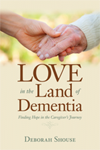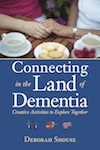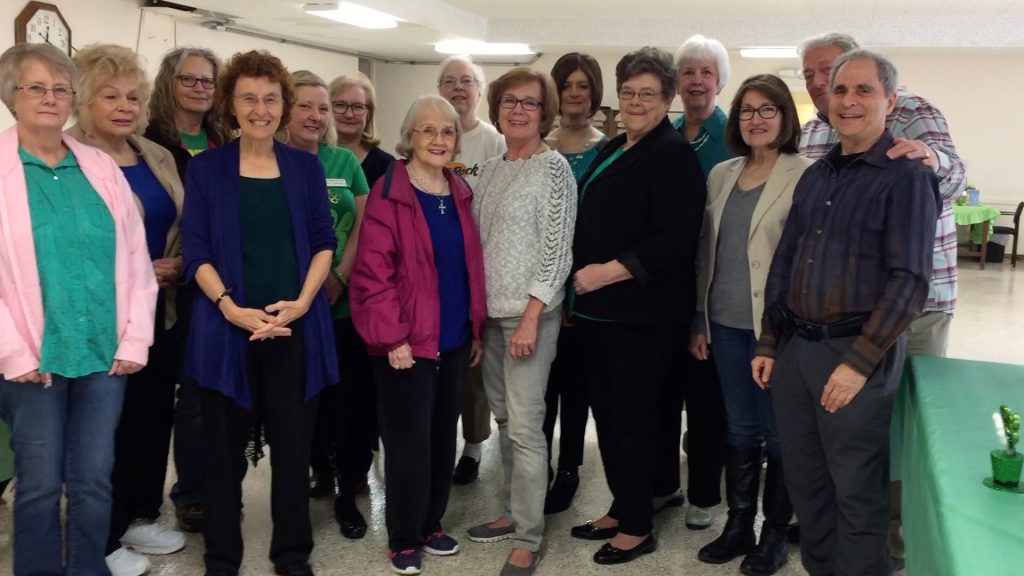Relationships
A Better Visit in the Land of Dementia
I’m always amazed at how a change of perspective can widen your heart and open your eyes. This is a story of how my friend helped me look at my mom in a new way and gave me me a better visit in the land of dementia.
Many weekday afternoons I stole away from my workday for a little rendezvous. I drove far into the southern part of the city.
There I hurried through the lobby, walked swiftly down the corridors and until I reached the locked door. There I punched in a secret code that allowed me into the inner sanctum, the memory care unit where my mother lived.
Walking into my mother’s room was always a surprise: I never knew who would greet me; a sweet curly-haired woman wearing a pink sweat suit and looking quietly compose? An anxious haggard woman who bent to pick up invisible lint on the floor and jabbered with invisible creatures lurking in the corners? Or an exhausted former beauty, lying across the single bed wearing an orange pullover and an adult diaper? My task was to appreciate every aspect of my complicated mother and whoever she was at the moment.
When my friend Maril asked, “Can I go with you to visit your mother?” I felt like a flutter of angels had gathered around me.
“Really?” I asked. “You want to see Mom with me?”
She did. I prepared her for our visit, describing Mom’s various moods. Maril did not seem shocked, worried or afraid. I told her about walking into the sometimes chaotic energy of the locked Alzheimer’s unit. She simply nodded as if this were an ordinary occurrence, which, for me, it was.
The day of our visit I felt lightness inside; I was eager to share my secret world with my friend.
Throughout the years, Mom has always been gracious with my friends and that day was no exception. Mom was sitting at a table in the dining room with a magazine in front of her. She looked pretty and serene and she smiled when we came in. We sat next to her and Maril took her hands.
“How are you Fran?” Maril said, looking into my mother’s eyes.
“Well I you know the scatter of it all,” my mother answered.
“I do know the scatter of it all. How are you getting along here?”
“Like a diamond in the sky,” my mother said.
As I listened to my mother and my friend talk, I was so moved.
“Your mother is really something,” Maril said as we left the home. “I enjoyed seeing her. I’d like to go again with you sometime.” I was proud of my mother’s poetic and eccentric answers, proud of the way she engaged in the conversation. And I was grateful that my friend was able to appreciate my mother, listen to her words and intuit their deeper meaning.

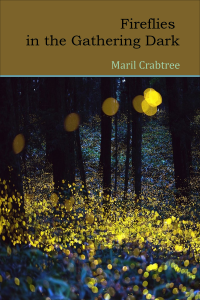 The visit was a huge gift for me. Seeing Maril engage with and appreciate my mom just as she was reminded me of the depths of my mother’s many talents and facets. This knowledge later helped me get through those moments when my mother seemed faraway or lost. My friend reminded me that there are so many ways to carry on a good conversation. All you need is attention, intention and love.
The visit was a huge gift for me. Seeing Maril engage with and appreciate my mom just as she was reminded me of the depths of my mother’s many talents and facets. This knowledge later helped me get through those moments when my mother seemed faraway or lost. My friend reminded me that there are so many ways to carry on a good conversation. All you need is attention, intention and love.
Deborah Shouse is the author of Connecting in the Land of Dementia: Creative Activities to Explore Together and Love in the Land of Dementia: Finding Hope in the Caregiver’s Journey.
Connecting Through Reading Together: Wisdom from Anne Vize
Connecting through reading together has always been part of my life, starting with my mother reading me Mother Goose and Grimm’s Fairy Tales. Even when Mom was living with dementia and could no longer track a Shakespearian play or a complicated novel, she loved holding books and she enjoyed hearing lyrical poetry. I was excited when I discovered the work of Anne Vize, Curriculum and education writer, instructional designer, and author of ‘Reading in the moment – activities and stories to share with adults with dementia’ published by Speechmark.
Anne graciously shared her insights for this blog.
Connecting Through Reading Together: Wisdom from Anne Vize
Why is reading together so important?
Reading is a powerful but sadly often forgotten tool for supporting people who have dementia. Sometimes people worry that they might not read fluently enough, or they might make mistakes when they read, and so avoid doing it all together. But people have been reading together throughout time, and the idea of sharing pose, poetry and stories is an integral part of who we are as people. Just because someone has dementia does not mean they are unable to benefit from the joy of sharing a moment in time, with a great book or piece of text.
How do you get started?
Start small and keep the reading sessions to around 10-15 minutes to begin with. Plan ahead so you know what you are going to read and the sort of ‘voice’ you will use to read it. Some texts are more suited to a bouncy, entertaining voice while others are better suited to a slow, lyrical, smooth reading style. Pick the one that suits the piece you are reading, as well as the one that suits who you are as a reader.
How do you set the scene?
Sometimes a sensory experience to begin with can be useful, or a brief discussion about the personal experiences of the listener that might relate to the story. You can make a link with seasonal activities such as Easter, Christmas, Passover, Independence Day or Anzac Day, but be aware that these festive or commemorative times might trigger particular memories for some people that might be unintended. Be sensitive and make sure you know a little about the piece you have chosen and the person you are reading to.
What kinds of stories/books do you suggest?
Read something you are comfortable with. Avoid texts with long, complex sentence structures or multiple characters, as these can be difficult for the person living with dementia to follow. Focus on stories you can read in a single session, with a limited number of characters, and a plot that only moves in a forwards direction (not something that jumps from one period of time to another, as sometimes happens in the short story genre).
How do you use the stories as conversation catalysts?
You can link what you read with a discussion, activity, or sensory experience, if it seems appropriate. For example, you could read the Australian bush poet Banjo Patterson and then combine this with a sensory experience looking at photos of the Australian bush, exploring plants, and leaves outdoors or listening to the sounds that horses hooves might make on the ground. If you are comfortable wearing a bush hat (called an Akubra in Australia) and a check shirt as you read some bush poetry, all the better!
How do you make the experience meaningful and fun?
Use your judgment and knowledge of the person you are reading to. Think about her needs and personal comfort and monitor how she is faring during your reading session. Think about sensory elements in the room that might interfere with your reading, such as outside noises, distractions outside the window, people moving in and out with meals or drinks, and the like. These can all take away from your reading experience.
Reading has a tendency to create a feeling of peace, calm and harmony for people and can be a trigger for more conversation and interaction. Even if the person does not recall the reading experience after you have finished, they will retain the mood and feeling that the piece has created for them and this may well last for long after the actual reading experience has ended.
To learn more about Anne, please visit, https://www.facebook.com/pg/Anne-Vize-Writing-Services-126820110730385/posts/?ref=page_internal

Reading in the Moment: Activities and Stories to Share with Adults with Dementia
Deborah Shouse is the author of Connecting in the Land of Dementia: Creative Activities to Explore Together and Love in the Land of Dementia: Finding Hope in the Caregiver’s Journey.
The Marvels of Misplacing
“I don’t know where my glasses are,” Mom tells me. I bite my lip; she’s been misplacing things all day. We are supposed to be spending a day drawing and painting, trying to connect mom with the artist she used to be. We are supposed to bake cookies together and look through magazines. But I’ve been spending much of the time crawling around, looking under the sofa and chairs and between the cushions for the disappearing glasses.
“Let’s make our cookies. You won’t need your glasses for that,” I say.
“I need my glasses.”
As I search, I wonder when it became a drudgery instead of a joy to find things. One of my favorite childhood games was Hide ‘N Seek. I loved being the Seeker, loved the surprise of finding someone in a tucked away, mysterious place. I had a special trick I used when I was “It.” I would close my eyes and say, “If I were Dan, where would I hide?” Then an image floated into my mind and I’d race to the hiding place. Half the time, I was right.
Do I still have “it?” I close my eyes and think, “If I were Mom’s glasses, where would I be?” The refrigerator comes to my mind. I rush into the kitchen and fling open the refrigerator door, only to see the usual chaos. But I’m hungry, so I reach for an apple. Behind the fruit is a pair of reading glasses, sprawled across the shelf.
Triumphantly, I take the glasses to Mom.
“These feel nice,” she says.
Not only has my mother reminded me of the importance of creativity, curiosity and play, but she also discovered a great summer time tip: chill your glasses and cool off your face.
Deborah Shouse is the author of Connecting in the Land of Dementia: Creative Activities to Explore Together and Love in the Land of Dementia: Finding Hope in the Caregiver’s Journey.
They Yearned for Freedom
I often think of my grandparents, each of whom bravely made his and her way to America. They sought opportunity and they yearned for freedom. Freedom to be safe from persecution, freedom to practice their religion, freedom from stigma, freedom to be their own true selves. The same things we all want. Here’s to living our dreams and to helping others live their dreams.
When I was growing up, in the 1950s, the Fourth of July was a true day of freedom. We had a huge family picnic at our relative’s house. The festivities included a swimming pool and was held in a neighborhood without fences, which meant we kids could run breathlessly through the yards, chasing each other, playing tag, baseball and hide ‘n seek.
But first, we politely greeted our relatives. Then our aunt said, “How about a drink?” to my parents. And “Kids, there’s sodas in the cooler.” Dad wanted Scotch on the rocks and Mom asked for gin and vermouth. Mom joined the women who were arranging the food on long picnic tables and Dad hung out with the men, who were grilling burgers and dogs.
That’s when the freedom began. My younger brother Dan and I, normally allowed to drink only juice and milk, eagerly surveyed the array of icy sodas and we both chose Grape Nehi.
Quickly we were swept into a game of tag. Some of the kids were already wet from swimming and others still wore shorts. Underneath our clothes, Dan and I had on our bathing suits and were ready to leap into the pool and get immersed in a game of Marco Polo.
The adults were busy with drinks and conversations and no one admonished us to be quieter, slower, or more polite. We were a band of glowing energy, sweating with the joy of freedom and racing to escape being IT. We were a burst of independence, throwing off our shorts and t-shirts and cannonballing into the pool, shrieking, splashing, and laughing.
After several hours, the women beckoned us over. We dropped onto the lawn and ate ravenously off drooping white paper plates loaded with baked beans, hot dogs, corn, cole slaw, and potato chips. Then we spit watermelon seeds at each other. Finally, we sated ourselves with rich chocolate cake.
By then, the fireflies flickered and glowed. My uncle handed out sparklers without even warning us to be careful. Those dangerous sulphury sparks thrilled us. We raced about, a sparkler in each hand, writing our names on the sky, streaking across the dewy grass, leaving a trail of smoldering light behind us.
At the end of the evening, my uncle set up the fireworks. We sat on blankets, this time with our families. We were smudged, sweaty, and stained with watermelon juice and dirt. I leaned against Mom and my brother snuggled next to Dad. As the fireworks spurted up into the sky, we pressed our hands against our ears, the noise and brilliant layers of light bursting around us.
“God bless America,” my father said.
“America,” the adults echoed, their voices hushed and reverent.
Only later, when I was older, did I realize the significance of the holiday: my relatives were all first generation Americans—and on that day, among others, they were grateful their parents had escaped the tyranny and religious persecution of Poland, Russia, and Hungary and had come to this welcoming land.
But that night, I was simply worn out from my own childlike version of independence. Dan and I leaned against our parents, fighting our tiredness, and let the sounds of freedom ring us to sleep.
Deborah Shouse is the author of Connecting in the Land of Dementia: Creative Activities to Explore Together and Love in the Land of Dementia: Finding Hope in the Caregiver’s Journey.
Redefining Dementia and Focusing on Wellbeing
Several months ago, I was delighted to write an article highlighting some of the American leaders in dementia care. I will be occasionally spotlighting luminaries from that article who are redefining dementia and focusing on wellbeing.
A version of this piece appeared in Signpost Journal: Journal of Dementia and Mental Health of Older People. This excellent journal from Wales, UK, offers a variety of informational and inspirational articles. I am honored to be a contributor.
Redefining Dementia and Focusing on Wellbeing
Late every afternoon, Roger paces the corridors, pausing at the locked door, fiddling with the keypad, sometimes even setting off the alarm before he resumes his pacing. Instead of labeling Roger’s behavior as “sun downing,” Allen Power, MD, teaches practitioners to ask themselves: Which vital element of health and happiness is missing from Roger’s life: identify, connectedness, security, autonomy, meaning, growth, and joy. By doing this, Dr. Power is redefining dementia and focusing on wellbeing.
Dr. Power is a geriatrician and educator on transformational models of care, with a focus on people living with changing cognitive abilities. He is also the author of two groundbreaking books, Dementia Beyond Drugs and Dementia Beyond Disease: Enhancing Well-Being.
He defines dementia as, “A shift in the way people experience the world around them.”
“I believe that most of people’s on-going distress is due to the erosion of one or more aspects of well-being, from the care environment, and/or the person’s cognitive changes. Imagine these domains of wellbeing as seven glasses being emptied. Start filling the glasses and notice the results.”
As Dr. Power trains and consults with memory care communities around the world, he sees meaningful results from this compassionate approach. Suddenly, Mary is not constantly calling out night and day. Bill is not hitting the aides when they take him to the shower. Roger is not setting off the alarm or trying to open the exit door.
“There’s no sure answer,” Dr. Power says. “You need to understand the individual and experiment until you reach the root of the problem. People may be looking for connectedness. They may feel anxious and insecure. They may be bored.”
If someone is repeatedly trying to leave the building, Dr. Power might ask: Are they feeling insecure? Are they feeling lonely and trying to reach someone they love? Are they yearning to connect with an important part of their identity, such as a beloved garden, horse, dog, or pick up truck?
Working toward an Inclusive Future
Dr. Power uses a strength-based approach to work on enhancing wellbeing. He encourages developing “brain ramps,” cognitive supports that help people move through the day in meaningful ways.
“With this positive approach, I can now look at a challenging scenario and offer insights,” Dr. Power says.
Beyond the care of the individual, Dr. Power believes in examining ingrained rituals and routines of institutionalized care, including all meals at a certain hour, with an aim of moving to a more individualized and meaningful mode of care.
“We can make mundane activities such as bathing or getting ready for bed more meaningful and relational than we normally do in long-term care,” he suggests.
“We need to support people instead of dehumanizing them,” he says. “We need to be inclusive and try harder to understand them.”
Dr. Power believes integration into society is a basic civil right.
“Imagine if people who lived with cancer, arthritis, or diabetes could only live with others who shared their medical condition. There’s a problem with seeing the disease instead of the people,” he says.
Dr. Power is contributing to a future where all communities are dementia inclusive and where dementia is just viewed as another way that people see the world.
For more about Allen Power, MD, internationally known geriatrician, educator, and author , please visit:
Website: http://www.alpower.net
Dr. Power is participating in Dementia Action Alliance’s Reimagine Life with Dementia Conference, June 25-27.
http://daanow.org/wp-content/uploads/2016/10/DAA-Conference_042817.pdf
Deborah Shouse is the author of Connecting in the Land of Dementia: Creative Activities to Explore Together and Love in the Land of Dementia: Finding Hope in the Caregiver’s Journey.
Make Dreams Come True
All her life, my mother dreamed of visiting Japan. She loved Japanese art, food, and culture. But she thought such a trip was too expensive and complicated. Even as Mom struggled with cognitive impairment, her yearning of Japan remained. Then my brother moved to Tokyo and prepared to make dreams come true. He arranged for business class travel for Mom and Dad. He squired my parents everywhere and even set up a meeting with a Japanese master potter. He documented it all with photographs so we could all share in the joy.
Recently Ron and I visited Edencrest at Green Meadows in Johnston, Iowa, to learn more about their memory care work. When Nick Lensch, Assistant Manager, and Susan Babcock, Life Enrichment Coordinator, told me about their Dare to Dream program, I wanted to learn more.
“This program brings happiness to the dreamers living with dementia, their families, the staff, and other members of the memory care community,” Susan told us.
As Susan gets to know each resident, she usually uncovers an unfulfilled dream. She brainstorms on how she can carry out the dream, including who can help from the community.
“Bringing the community in on the dream is wonderful for all of us,” she says.
Once she has the dream planned, she talks to the family. Often the dream experience is one the family treasures. Here are two of the dreams they orchestrated :
Joe had been a star baseball player in high school and a minor league player for a couple of years. He loved all things baseball.
“I wish my sons and grandson could have seen me play ball,” Joe often said.
Susan heard the wistfulness in his voice and created a plan. Partnering with the Iowa Cubs, she arranged for Joe to throw out the first ball during one of their games. Both his sons were there to witness their father, one son flying in from Japan for the event! Joe’s grandson stood by his side for the grand pitch, cheering him on. Then the entire family enjoyed watching the game together. #
Marianne loved to sing and often reminisced about times she and her father sang together.
“I wish I would go on the road and sing,” she often said.
Nick and Susan had an even better idea. They contacted a local singing group and asked if Marianne could perform with them. They were delighted to be part of her dream. Marianne selected favorite tunes. Her face shone with joy as she and the group performed to an enthusiastic audience, including her grateful daughter.
“We believe in embracing the moment,” Nick says. “Making dreams come true creates a string of treasured connective moments.”
To make dreams come true, here are a few tips:
- Listen to each person’s stories and notice favorite ones. Ask yourself, is there a wish or dream tucked into one of those tales?
- Double check with another family member or friend, to see if you’re on the right track.
- Brainstorm ideas to fulfill the dream. What do you need in terms of people, venues, witnesses? Who would enjoy helping?
- Put together a small team and set the time and place. Have someone ready to photograph and video the celebration.
For more ideas on how to make dreams come true, visit:
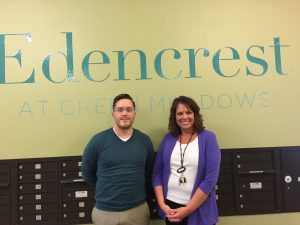
Nick and Susan
seniorhousingmanagement.org
Don’t forget your own dreams!
Deborah Shouse is the author of Connecting in the Land of Dementia: Creative Activities to Explore Together and Love in the Land of Dementia: Finding Hope in the Caregiver’s Journey.
Four Fine Ways to Keep Remembrances Blooming
How do you celebrate Mother’s Day or Father’s Day when your parents are no longer living? As the day approaches, I think of my parents and look for ways to keep remembrances blooming. During the years, I’ve explored ways to feel close with my mother, father, and other loved ones who have passed on. Here are four of the actions that keep me connected.
Dress to Connect
When I feel lonely for Mom, I like to put on her black blouse emblazoned with silver sequins. When Mom wore this blouse, it signified she was going someplace elegant. She accompanied it with a long black skirt and high heels. When I put on my ordinary black slacks and black tennis shoes, I imagine my mother shaking her head. “Don’t you have any better shoes, dear?” My mother prods me from beyond the grave, intoning, “A little lipstick would be nice.” Here’s the lovely part of our post-death ritual: instead of bristling at her grooming suggestions, I see how she wished the best for me and fondly remember her love of dressing up.
Feed your Memories
I still love to eat and share my parents’ favorite foods. My brother, who has untold culinary abilities, has mastered Mom’s butterscotch brownies and he has improved on her chocolate chip cookie recipe. He often bakes those for family gatherings and sometimes even mails me a box of nostalgic homemade treats. As for my dad, he particularly liked Planter’s Deluxe Nut Mix. He adored the cashews, but he didn’t want to spend the money to upgrade to all cashews. He preferred to pick out the deliciously rare morsels, leaving behind a plethora of peanuts, almonds, and hazelnuts. In his honor, I often buy a can of mixed nuts. Did you know that memorial cashews have no calories?
Tell their Stories
We all have heirloom family stories that anchor us in our history. My father liked to talk about his growing up days in the Canal Zone, in Colon, Panama. My mother favored her time serving as an Army nurse in Iceland during World War II. These were the stories of my growing up years and I think of them every time someone talks about Iceland, Panama, the Canal, or WWII. I have written some of them down so I won’t forget them. When I tell one of my parents’ stories, I feel they are in the room, leaning forward, smiling, and listening with delight. I like to share these tales at family gatherings and I like to tell them to friends. I also like to invite other people’s legendary stories.
Continue the Conversation
Sometimes I go on a solitary walk and talk to my mother. She loved birds and I point out the robins, cardinals, and sparrows on the route. I also tell her about my grandchildren, my work, and I discuss any dilemmas I’m struggling with. My father loved being in the water and I often commune with Dad when I’m swimming backstroke. I tell him entertaining things that are going on and talk to him about my dreams and big ideas. My parents are still good listeners and I picture them nodding proudly and cheering me on.
A version of this article originally appeared on MariaShriver.com
Deborah Shouse is the author of Connecting in the Land of Dementia: Creative Activities to Explore Together and Love in the Land of Dementia: Finding Hope in the Caregiver’s Journey.
Engaging during the Dementia Journey: One Story and Six Tips
My satchel was packed with potential connectors, not the electrical type, but the emotional, engaging type. I had a sheaf of favorite poems, an Audubon bird book, a list of songs Mom and I liked, some bright red Mardi Gras beads, several colorful scarves, and some paper and markers. I was eager to see what Mom might fancy and I felt prepared for any creative impulse. But as usual, my mom surprised me. When I walked into her room in the memory care community, she was sitting on the bed, fiddling around with a blanket. She smiled and held out her hands. I sat beside her, held her hands, and smiled at her. She laughed. I laughed. She made a little funny face. I mirrored her. I followed her lead until she suddenly gripped my fingers and closed her eyes. I closed mine, but kept sneaking peeks at her. She was asleep, a lazy smile on her face, so I closed my eyes and rested with her. This was one of many ways of engaging during the dementia journey.
Spontaneity and surrender were two of the many lessons my mom taught me during her dementia journey. I loved preparing for our time together, cobbling together ideas to engage us both. Sometimes we sat quietly, leafing through magazines. Other times, I sang Mom show tunes. Still other times, I simply went with the flow and enjoyed Mom’s energy and spontaneity.
My mom has since passed away but her spiritual and emotional gifts linger on. When I visit friends who are living with dementia, here are a few ideas for connecting.
- Choose a quiet space relatively free of distractions.
- Select a time of day when you both have lively energy.
- Bring a project (or projects) you’d both enjoy.
- If the person is shy about creative projects, issue a low-key invitation, such as, “Want to help me with this project?”
- Allow the activity to unfold at its own pace, offering support as necessary and encouragement along the way. Enjoy the process.
- If the activity doesn’t go as planned, don’t worry. Go with the flow and relish your time together.
(A version of this story was originally published in eCareDiary)
Deborah Shouse is the author of Connecting in the Land of Dementia: Creative Activities to Explore Together and Love in the Land of Dementia: Finding Hope in the Caregiver’s Journey.
Art as a Creativity Catalyst: Featuring Grace and Spencer Townley-Lott
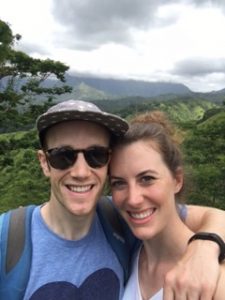
How do we keep our sense of connection and creativity through the caregiving journey? That was a question I often asked myself. I wanted to share this story of an extraordinary couple– artist, dementia advocate, and social worker Grace Townley-Lott and her husband, puppeteer, actor, and playwright, Spencer Townley-Lott. Both use art as a creativity catalyst in their work and throughout their lives.
Their elders inspired them. Grace and Spencer were teenagers when her grandmother and his great-grandmotherwere going through a dementia journey. The experience was difficult and impactful.
Grace became a social worker, specializing in older adults and learning how to communicate with people who were living with dementia, often through art.
“It’s incredible how the arts open people up,” Grace says. “Someone who hasn’t painted in 20 years picks up a brush and creates something beautiful. Someone who hasn’t spoken in ages delivers a zinger of a one-liner. Every day, I see how creative people are and the connections that are still possible.”
As Grace unfurled her work experiences, Spencer gained a new understanding of his great-grandmother’s last years. He used those insights to create a critically acclaimed play, Blossom. This play, which utilizes puppets, was funded by a Jim Henson Foundation Grant. It focuses on James Blossom, a retired painter who is living with dementia and his family’s changing relationships.
Caregivers often wonder: “How do we keep creativity alive?” Grace and Spencer were kind enough to share some ideas.
Engaging in New Endeavors: Grace
Try to be in the moment, despite your list of tasks. Respond to and validate emotions. Be willing to go with the flow so you can allow creative sparks.
Pay attention to facial expressions as you invite your loved one to engage. If you start dancing, do their eyes light up and do they laugh? If you offer watercolors and cue your partner to touch the brush to wet paper, does he respond with joy when the color blooms on the page? If you’re having a hard time getting your partner to take a shower, croon a song and waltz with him into the shower. If it doesn’t work, that’s okay, too! But if it does work, it’s a lovely and practical way to connect, create, and take care of physical needs as well.
Sometimes it takes reframing the situation to view the possibilities. An outside person or idea can often expand your thinking.
Creativity Tips for the Care Partner: Spencer
Sometimes, physical actions can help release tension to allow for more creative thinking. Deep breaths and stretching can help you loosen up at first. In the theater world, we start every rehearsal with a physical game or action to help us get focused and leave our stress at the door. Try wiggling and shaking your feet and hands, giving yourself a brief facial massage, stretching as tall as you can, and twisting gently left and right. You’re getting the blood flowing, leaving the worried part of you in the hallway, and getting ready to create.
Allow room for surprises. Try to set the tone by modeling joy and openness. Be willing to try again.
Connecting through Art: Grace
I love viewing art with people who have dementia. Art is so subjective, so there’s no wrong answer to the question, “What do you see?” You can take that first question and lead it along into a fascinating conversation, one question at a time, building a fulfilling conversation with an individual or a group.
In these art viewings, a discussion about a painting can tap into emotions that would otherwise be left undiscussed, or it could lead into a beautiful conversation about the person’s childhood, for example. You never know where the conversation will lead! This creates a failure-free situation where a person with dementia can excel and their answers are valued.
Connecting through Puppets: Spencer
Puppets offer a level of separation for the care partner. For people living with dementia, a puppet’s cues may be simpler to decode, dramatically expressing joy or sorrow. The puppet can place a hand on a shoulder and offer many opportunities for sensory engagement.
Puppets can also encourage intergenerational play, creating connections between family members who may be unsure who to communicate with their loved one with dementia.
Keeping Your Creative Flow: Spencer and Grace
“Creativity is inherent in all of us,” Spencer says. “It’s a muscle you can strengthen. Be patient with yourself. The first day, you can only do one push-up. The second day, you can accomplish two or three. That’s what creativity and artistry feels like. Start small. You are laying the foundation. And it gets easier.”
“Be present and be ready for anything,” Grace says. “By asking your loved ones for advice, truly listening to them, and just being with them, you can form beautiful interactions throughout life.”
To learn more about Spencer, visit
To learn more about Grace, visit
gracetownley.com and theartfuloven.com
Grace is the Director of Truly Inspired Outreach and Education for True Care Home Health.
Deborah Shouse is the author of Connecting in the Land of Dementia: Creative Activities to Explore Together and Love in the Land of Dementia: Finding Hope in the Caregiver’s Journey.
Sharing Ideas for Staying Connected
“How do we stay connected during the dementia journey?” This is a question with dozens of creative answers. Recently, we spent time at Northland Shepherd Center, hosted by Dianna Englander. We were sharing ideas for staying connected with the Together We Care Caregiver Support Group, a lovely gathering of family caregivers and friends. 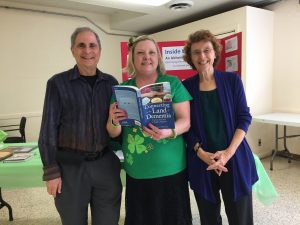
Caregiving is such a creative practice, demanding flexibility, humor, and the willingness to make mistakes and try again. We discussed ideas from Connecting in the Land of Dementia, including incorporating singing, laughter, and art into everyday life. We also explored the power of nature and talked about unique concepts for bringing the outdoors inside. We brainstormed different ways we could prepare food together and connect in the kitchen.
Here are some extra ideas we learned from our audience. I’ve changed the names to protect people’s privacy.
Anne’s father, who was normally very active, became very upset when his care facility had to temporarily curtail his movements, due to a flu outbreak.
“I want to go to the hospital,” he told the care staff repeatedly. Finally, they called Anne and asked her to come over.
“Dad was just wild,” she told us. “So I asked him to take a deep breath with me, and told him we were going to watch a basketball game before we problem-solved.” They watched an hour of basketball, which soothed both of them.
“I want to go to the hospital,” her father said.
“Why?” she asked.
“So I won’t feel alone,” he said. “I’m scared to be alone.”
Anne realized how social her father was, always walking down the hallways, greeting people, spending time visiting. She instantly began to problem solve, getting permission to walk down the corridors, wearing protective masks, gathering phone numbers of her father’s friends at the home, so he could call them.
“Taking a break and doing something soothing first really helped us figure out the problem and then solve it,” she said.
…………………….
Before her dementia advanced, Sandra’s friend loved singing in the church choir. Now, when Sandra visits her, her friend frequently asked the same question over and over. Sandra turns to beloved hymns they both know so well and when her friend becomes anxious, starts singing to change the energy. Soon, they are both singing, as they have for so many years, the old hymns guiding them back to a deep connection.
…………………….
Patriotic songs inspired Alvin’s father, Fred. So often, Fred literally tuned out the singers who came to entertain at his memory care community. One day, the group began singing “The Star Spangled Banner,” Instantly, Fred stood and put his hand over his heart. He sang along and kept standing and singing through all the familiar patriotic melodies. Afterwards, he talked about his time in the service, breaking his usual stoic silence.
At the end, we all felt a sense of renewal and companionship. Sharing these important creative ideas had enriched our lives and inspired us anew.
I’d love to hear your ideas for staying connected. Please email me at myinfo@pobox.com.
For more information about the Northland Shepherd Center, visit http://northlandsc.org/about-nsc.html
Deborah Shouse is the author of Connecting in the Land of Dementia: Creative Activities to Explore Together and Love in the Land of Dementia: Finding Hope in the Caregiver’s Journey.
